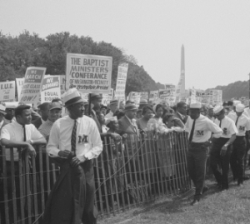 side of fence, B&W photo" />
side of fence, B&W photo" />The Civil Rights Act of 1964 was the nation's premier civil rights legislation. The Act outlawed discrimination on the basis of race, color, religion, sex, or national origin, required equal access to public places and employment, and enforced desegregation of schools and the right to vote. It did not end discrimination, but it did open the door to further progres
Although the 13th, 14th, and 15th amendments outlawed slavery, provided for equal protection under the law, guaranteed citizenship, and protected the right to vote, individual states continued to allow unfair treatment of minorities and passed Jim Crow laws allowing segregation of public facilities. These were upheld by the Supreme Court in Plessy v. Ferguson (1895), which found state laws requiring racial segregation that were "separate but equal" to be constitutional. This finding help continue legalized discrimination well into the 20th century.
Following World War II, pressures to recognize, challenge, and change inequalities for minorities grew. One of the most notable challenges to the status quo was the 1954 landmark Supreme Court case Brown v. Board of Education of Topeka, Kansas which questioned the notion of "separate but equal" in public education. The Court found that "separate educational facilities are inherently unequal" and a violation of the 14th Amendment. This decision polarized Americans, fostered debate, and served as a catalyst to encourage federal action to protect civil rights.
 side of fence, B&W photo" />
side of fence, B&W photo" />
Each year, from 1945 until 1957, Congress considered and failed to pass a civil rights bill. Congress finally passed limited Civil Rights Acts in 1957 and 1960, but they offered only moderate gains. As a result of the 1957 Act, the United States Commission on Civil Rights was formed to investigate, report on, and make recommendations to the President concerning civil rights issues. Sit-ins, boycotts, Freedom Rides, the founding of organizations such as the Student Nonviolent Coordinating Committee (SNCC) and the Southern Christian Leadership Conference (SCLC), local demands for inclusion in the political process, all were in response to the increase in legislative activity through the 1950s and early 1960s.
1963 was a crucial year for the Civil Rights Movement. Social pressures continued to build with events such as the Birmingham Campaign, televised clashes between peaceful protesters and authorities, the murders of civil rights workers Medgar Evers and William L. Moore, the March on Washington, and the deaths of four young girls in the bombing of Birmingham's 16th Street Baptist Church. There was no turning back. Civil rights were firmly on the national agenda and the federal government was forced to respond.

In response to the report of the United States Commission on Civil Rights, President John F. Kennedy proposed, in a nationally televised address, a Civil Rights Act of 1963. A week after his speech, Kennedy submitted a bill to Congress addressing civil rights (H.R. 7152). He urged African American leaders to use caution when demonstrating since new violence might alarm potential supporters. Kennedy met with businessmen, religious leaders, labor officials, and other groups such as CORE and NAACP, while also maneuvering behind the scenes to build bipartisan support and negotiate compromises over controversial topics.
Following Kennedy's assassination in November 1963, both Martin Luther King, Jr. and newly inaugurated President Lyndon B. Johnson continued to press for passage of the bill – as King noted in a January 1964 newspaper column, legislation "will feel the intense focus of Negro interest. It became the order of the day at the great March on Washington last summer. The Negro and his white compatriots for self-respect and human dignity will not be denied."
The House of Representatives debated H.R. 7152 for nine days, rejecting nearly 100 amendments designed to weaken the bill. It passed the House on February 10, 1964 after 70 days of public hearings, appearances by 275 witnesses, and 5,792 pages of published testimony.

The real battle was waiting in the Senate, however, where concerns focused on the bill's expansion of federal powers and its potential to anger constituents who might retaliate in the voting booth. Opponents launched the longest filibuster in American history, which lasted 57 days and brought the Senate to a virtual standstill.
Senate minority leader Everett Dirksen nurtured the bill through compromise discussions and ended the filibuster. Dirksen's compromise bill passed the Senate after 83 days of debate that filled 3,000 pages in the Congressional Record. The House moved quickly to approve the Senate bill.
Within hours of its passage on July 2, 1964, on what would have been the 39th birthday of civil rights activist Medgar Evers and with Martin Luther King, Jr., Dorothy Height, Roy Wilkins, John Lewis, and other civil rights leaders in attendance, President Lyndon B. Johnson signed the bill into law, declaring once and for all that discrimination for any reason on the basis of race, color, religion, sex, or national origin was illegal in the United States of America.
What is it? A landmark piece of civil rights legislation.
Significance: Outlawed discrimination on the basis of race, sex, religion, color, or national origin.
Date: July 2, 1964
Associated Sites: The United States Capitol, The White House